Whole Disk Sun Stuff
2/09/2023. It lacks the pizazz of the close-up stuff, but whole-disk solar imaging is satisfying in its own way. Sooner or later, I'm going to add a Quark to the kit, use the TMB92SS for solar imaging, and probably sell the Lunt gear in the interests of portability. Not today.
The kit and techniques worked out on the previous page come together into this, about which I have no complaints at all:
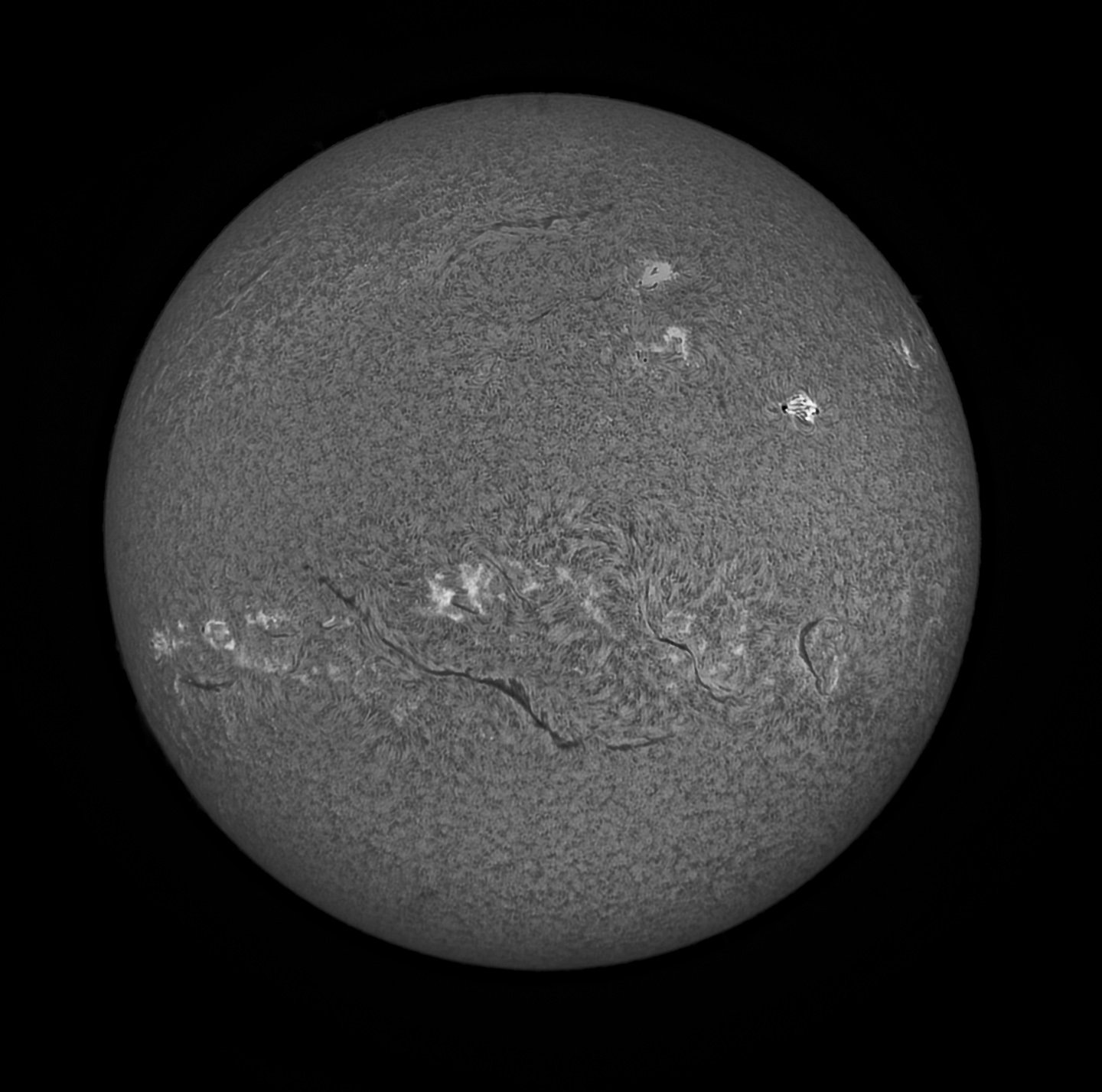
Lunt 60, B600, single-stack, reducer.
ASI178MM, best 300 of 1,000
Flatfielded with USPS diffusor.
Make it large.
That's two layers of USPS bag material for the flatfield (50 frames, 280ms) and then the best 300 of 1,000 frames using the same gain, filter configuration, orientation, and focus as the flat frames. I cannot for the life of me see much difference in surface detail between 8-bit and 12-bit (14, 16?) clips. I had to look at the capture log to know which this is (it's 8-bit; also from the log: very close to unity gain, 479 microseconds per frame, 90% histogram, gamma off, AVI format). Greater bit depth makes histogram-stretching for both disk and limb detail easier, but when the rim is not putting on a show, don't bother. Tuning the filter makes a huge difference in both sensitivity to Ha detail and evenness of illumination -- no surprise there, but pay attention to see if whole disk imaging needs more frequent adjustment than when using the Frankenscope to capture a much smaller part of the image plane.
The effective focal length of the outfit with the Antares 0.5x reducer mounted just ahead of the sensor (inside the snout, right up against the ASI178MM's window) is 435mm. The Frankenscope is/was 1,172mm. What kind of results would I get if I increased the EFL of the Lunt 60? Until now, I've been working to reduce its EFL for full-disk imaging. Look, at 90mm the Frankenscope has a theoretical resolution limit of 1.53 arc seconds. By the same token, the 60mm Lunt's limit is 2.3 arc seconds. I doubt my daytime sky ever offers seeing as good as either can do, so, y'know, it all comes down to processing in either case. Before paying dearly for a filter to use the 92mm TMB, let's see what's possible with some more magnification behind the 60mm Lunt. The Frankenscope was working at F13. To work at the same f-ratio, the Lunt needs to be working around 780-900mm. I think the little Lunt might be surprisingly capable with some meticulous processing.
2/15/2023. A very casual test proves promising. I put the 5x PowerMate into the imaging train just ahead of the ASI178MM and the camera came to focus at something like an EFL of 2,200mm. There were altostratus clouds blowing through making real imaging impossible, but I took a few clips as proof of concept. The slower F-ratio and the need to use the whole frame for a reasonable field of view mean frame rates are reduced. I need a clear sky to judge better how much (I was using 50-80ms under these cloudy skies, but infrequent clearer patches let me spin that down to 5-10). On the screen, detail looked pretty credible even without tuning or adjusting. But where is all that lint? It really shows up at this long F-ratio. Another good cleaning is in order, and then we'll test the limits of solar flatfielding. (All or most of that debris may be on the compressor which I left in place for this session.) Some clear day soon, work through various spacers and barlows and find out whether higher magnifications behind the Lunt is an avenue worth exploring. Expect success.
2/18/2023. This morning offered good seeing and clear air. So I set up to do some more careful imaging with the 5x Powermate behind the 60mm Lunt. I left the Antares compressor in place, as much for simplicity and to serve as a dust shield for the sensor as for anything else. Flats through the double-diffusion plastic had to be exposed on the order of 3 seconds(!). Actual exposures were 3-5ms. The image scale works out to about 0.22" per pixel, and that small objective can do 2" at best, so this is a lab exercise in oversampling. Are these photos as clear as the best I have with the 90mm Frankenscope? No, they are not. Are they "close"? Are they pretty good for a 60mm telescope riding a mount sold as a wide-angle astrophoto accessory? Yeah, I think so.
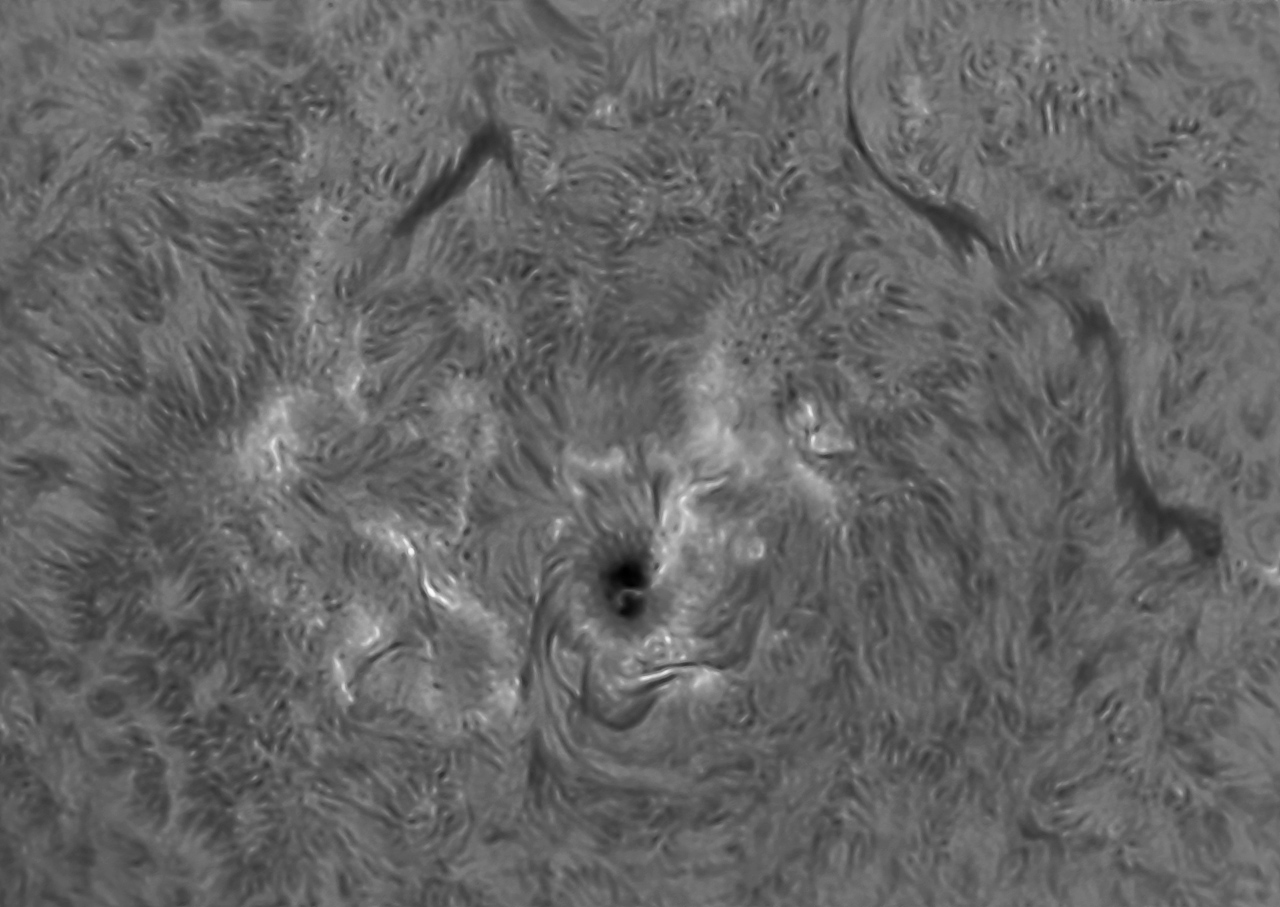
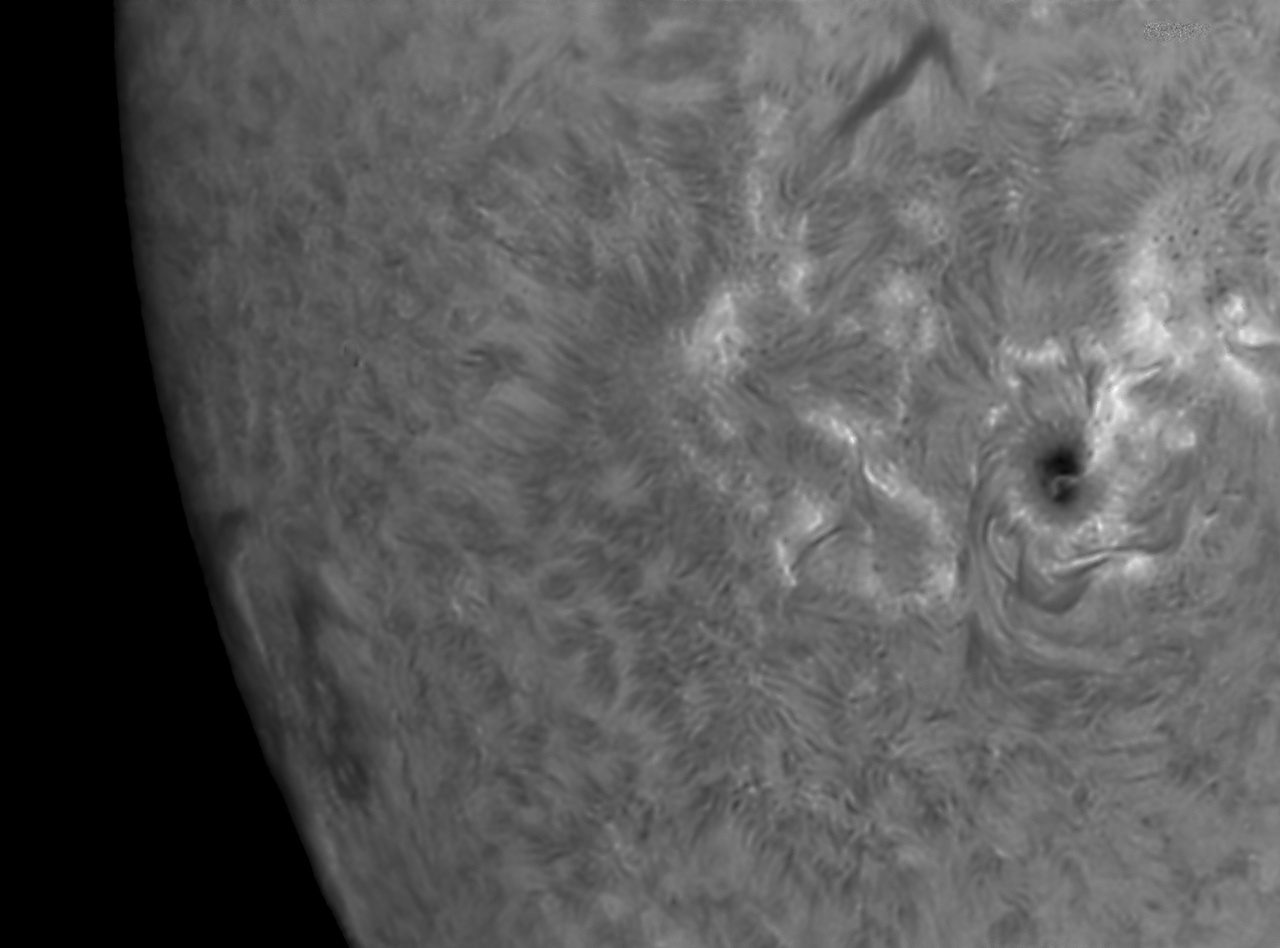
Best 150 of 1,000 frames.
Full-frame, ASI178MM, unity gain.
Captured and flatfielded in Firecapture 2.7
Guess what happens if you click on them.
The larger presentations lack -- that is to say they are even farther from -- that killer detail I would like to have in close-up solar photos. Backing off from the 5x Powermate to a 2x or 3x amplifier might be wise. Or maybe there is more care to be taken in focusing. Or maybe results would improve with taller stacks than 150 out of 1,000 frames. Those sorts of avenues are worth working on but so is not being disappointed when the results from a single-stacked telescope smaller than a breadloaf don't rival those from narrower filters behind much larger apertures. Maybe hardware can be upgraded by and by. For now, practice, Mister, practice.
One more from today. I'm not usually a fan of these inverted palette images, but sometimes they do exactly what you need them to do (including concealing a certain lack of resolution). This a two frame mosaic, not to get the rim and the disk, but both of the disk to increase the field of view. The rim just came along with an aggressive histogram stretch.
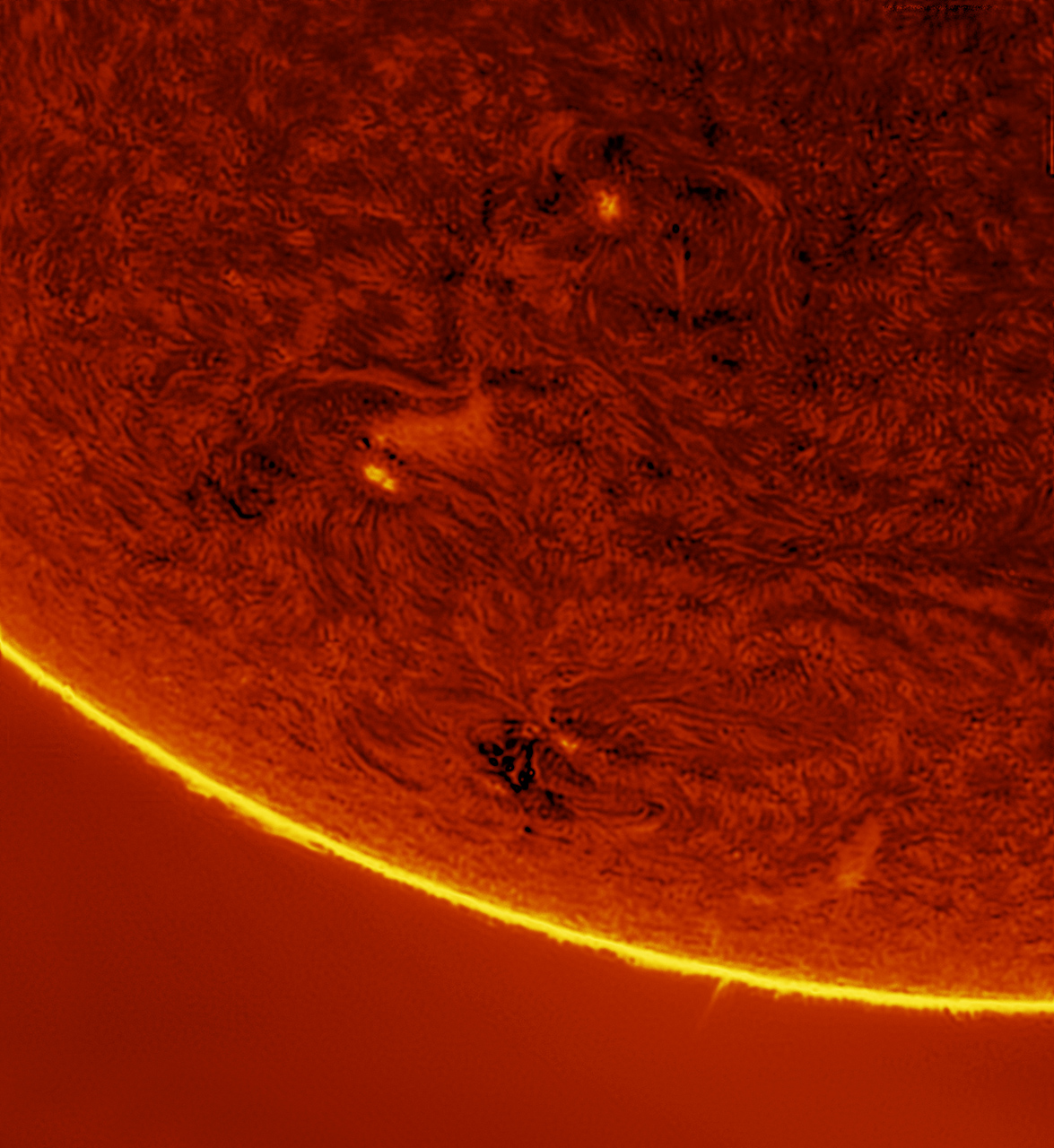
Same techspecs as others on this page, except
a two-panel mosaic, some histogram shenanigans,
and a colorful palette.
2/20/2023. The 5x Powermate is clearly overkill, but the images above demonstrate that the little 60mm can do a lot more than full-disk imaging. I spent some time looking for less powerful Powermates, but the ones I found were too pricey, all things considered. So I looked for 2-3x Barlows and found tons to pick from. I settled on a 3x model with an apochromatic lens and threads top and bottom so I can use it for purposes other than monochromatic sun gazing should such a hunger arise. Not too cheap, not too expensive; let's hope it's just right. Film at eleven (or at least video when the sky clears).
2/28/2023. You know, I'm just never going to get the kind of solar detail I want with a 60mm objective. That said, the seeing today was terrible. But my timing was perfect. Just as I got set up with the new 3x Barlow on the only clear day in the extended forecast, the Sun let loose an M8.6 or 8.7 flare. It was huge!
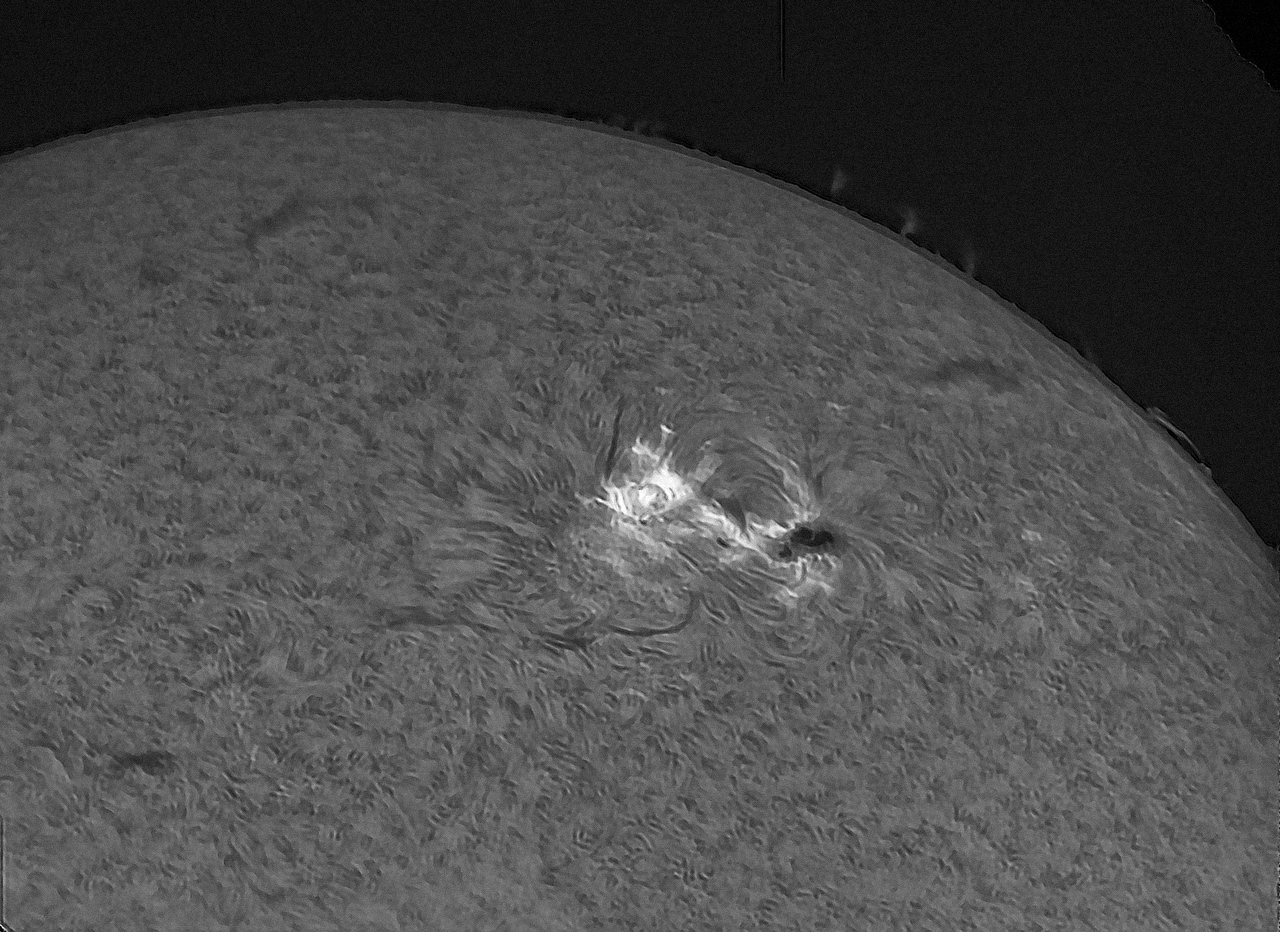
Lunt 60, single-stacked, 3x Barlow
ASI178, panorama, two full frames, 8-bits
Best 500 of 2,000 and Best 500 of 1,000
You can make it big, but it's better not to.
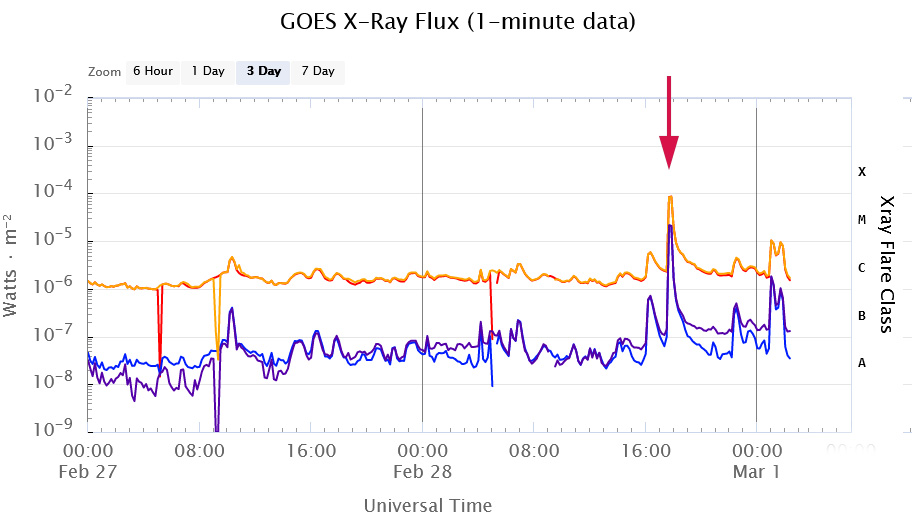
Timing isn't everything, but it's not nothing.
When I used the doubled flat-diffuser, exposures were almost 1-second long even with gain boosted a bit. Still, they worked fine. Actual capture exposures were about 650 microseconds to try to freeze terrible seeing and wind motion while not saturating the sensor with the brightest bits of the developing flare. The usual drill: focus at near minimum gamma, image with the gamma option unchecked. This time I used 8-bit AVI format. Next time, get polar alignment a bit better and try taller stacks to cope with dreadful seeing.
My solar images are made using a tilt-tuned Lunt 60mm telescope with a B600 blocking filter. I've been known to double-stack this instrument, but I mainly think of that as a visual, not photographic, configuration. The current camera (~2021 et seq) is an ASI178MM
chosen for its tiny pixels and fast capture rate. It is notorious for a nasty pattern noise which can be avoided with careful exposure or removed using FFT-based processing. I capture
data using FireCapture, stack using AS!3, deconvolve and perform initial histogram adjustments using IMPPG, and polish in Photoshop. As of 2023, the solar kit is mounted on a Skywatcher
Star Adventurer "tracking platform." Higher resolution imaging was with a "Frankenscope" using the Lunt OTA absent its objective behind a 90mm Orion achromat on a Meade LXD-55 mount.
:: top ::